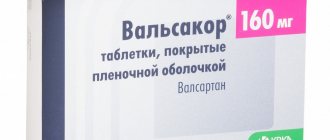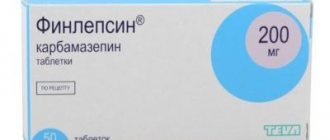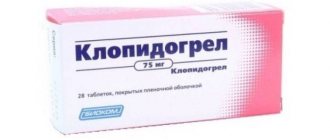What is Moxonidine
Due to its effectiveness, Moxonidine (other names Physiotens, Tenzotran) is widely used in international medical practice. The instructions for use indicate that the medicine belongs to the group of selective antagonists of imidazoline receptors (control the sympathetic nervous system). The medication has a hypotensive effect when taken once and when treated in courses. Does not affect cardiac output and HR (heart rate). Elderly and young people (over 18 years of age) are allowed to take the drug.
Physiotens (moxonidine)
Physiotens is a drug used in the treatment of arterial hypertension. The active substance, moxonidine, belongs to the group of centrally acting antihypertensive drugs. Its effect is associated with the stimulation of special receptors located in the brain stem. As a result of this effect, vascular tone decreases and blood pressure decreases.
An additional effect of moxonidine is an increase in insulin sensitivity, which reduces the risk of developing diabetes.
The use of physiotens leads to the relief of spasm of peripheral vessels, due to which blood pressure indicators decrease. At the same time, the frequency and strength of heart contractions do not change significantly.
Features of moxonidine
The difference between moxonidine (physiotens) and many other antihypertensive drugs is its minimal effect on adrenergic receptors. Clinically, this is reflected in a lower frequency of side effects such as drowsiness and dry mouth.
The drug is quickly absorbed from the digestive system: the maximum concentration of moxonidine in the blood occurs within an hour after its administration. The rate of absorption of the drug does not depend on the connection with food intake.
Physiotens (moxonidine) is excreted from the body mainly by the kidneys in unchanged form and in the form of metabolites. One day after taking the drug, no more than 10% of the absorbed substance remains in the blood. In patients suffering from renal failure, the rate of drug elimination is significantly reduced, so the dose of moxonidine in such patients should be selected individually.
Indications for taking physiotens
Moxonidine (Physiotens) is prescribed to treat hypertension. Therapy should be carried out under the supervision of a physician. The frequency of visiting a specialist is determined individually.
Contraindications
The use of physiotens is contraindicated for:
- acute and chronic heart failure;
- some arrhythmias;
- bradycardia with a heart rate below 50 per minute;
- lactation;
- the patient's age is under 18 years;
- individual intolerance to moxonidine and auxiliary components of the drug;
- lactase deficiency;
- galactose intolerance;
- malabsorption of galactose (glucose).
Prescribing moxonidine to patients with renal and severe liver failure and angina requires special caution and careful monitoring.
There are no data on the use of physiotens during pregnancy. Animal studies have shown that moxonidine can have a toxic effect on the fetus, so the use of the drug in pregnant women is permissible only in extreme cases, strictly as prescribed by a doctor.
How to take physiotens
Taking moxonidine usually starts with 1 tablet of 200 mcg once a day - time and connection with food intake do not matter. If necessary, the dosage can be gradually increased, but not more than 600 mcg per day. In the latter case, the daily dose of physiotens should be divided into 2-3 doses.
The abolition of physiotens should be carried out gradually, gradually reducing the dosage over 10-14 days under the supervision of a doctor.
The prescription and dose adjustment of moxonidine (physiotens) should be carried out by a doctor. Self-medication in this case is unacceptable. Patients taking the drug for a long time should also be regularly examined by a specialist and undergo examination.
Is it possible to take moxonidine (Physiotens) simultaneously with other drugs?
Moxonidine can be used alone or in combination with other antihypertensive drugs, which in this case mutually enhance the effect of each other.
Drugs from the group of tricyclic antidepressants (azafen, imipramine, amitriptyline and others) can reduce their main effect when used together with physiotens. At the same time, moxonidine can enhance the hypnotic and sedative effect of antidepressants, ethyl alcohol and tranquilizers.
When used together, physiotens and lorazepam may improve memory in elderly patients.
Side effects of moxonidine
Taking physiotens may be accompanied by side effects, the most common of which are drowsiness, dry mouth, lethargy, fatigue and dizziness. Most often, these manifestations are most pronounced during the period of adaptation to the drug and often decrease on their own after 1-3 weeks from the start of use.
In addition, when taking moxonidine, side effects may include a sharp drop in blood pressure, headaches, sleep disturbances, digestive disorders, and back pain.
Symptoms of moxonidine overdose
If the recommended dose of physiotens is exceeded, the following manifestations are possible:
- headache;
- dizziness and collapse due to a sharp decrease in blood pressure;
- rise in blood pressure;
- change in heart rate - bradycardia, less often tachycardia;
- vomit;
- abdominal pain;
- breathing problems;
- loss of consciousness.
Treatment of overdose with moxonidine is symptomatic.
The use of moxonidine (physiotenza) in vehicle drivers
A special study of the effect of physiotens on the ability to drive a car has not been carried out. However, given the relatively high frequency of side effects in the form of drowsiness and lethargy, drivers and other persons whose activities require concentration and speed of reaction should be warned about this.
Source: https://z0j.ru/article/read/Fiziotenz-moksonidin.html
Compound
The active ingredient in the drug is moxonidine (there are Moxonidine tablets with 200, 300 and 400 mg of the substance). The medicine uses many auxiliary components, including: microcrystalline cellulose, castor oil, Tween 80, magnesium stearate, lactose monohydrate. The method of administration of the drug is oral, available in tablet form or in powder form. The effectiveness of the drug does not depend on the form of release, the main thing is to strictly follow the instructions for use.
Release form
Often, the drug Moxonidine is available in the form of round, biconvex, film-coated tablets. Depending on the color of the shell, you can determine the amount of active substance (light pink - 0.2 mcg, pink - 0.3 mcg, dark pink - 0.4 mcg). At the break, the tablets are predominantly white. The drug is presented on pharmacy shelves, packaged in blisters of 14-20 pcs. (depending on dosage). A cardboard box holds up to 7 blisters. The shelf life of the drug Moxonidine is 3 years.
Mechanism of action
The drug Moxonidine for blood pressure is quickly and completely processed in the gastrointestinal tract (gastrointestinal tract), its bioavailability is 88%. The degree of absorption of the drug into the blood is about 90%, the half-life is up to 3 hours. The volume of distribution of the drug is 1.4-3 l/kg body weight. The active substance of the drug is predominantly excreted by the kidneys (about 90%) during the day, a small part of the drug is excreted through the intestines. The maximum level of drug concentration in the blood is observed after 0.5-3 hours, the hypotensive effect of Moxonidine occurs after 10-15 minutes.
Pharmacological properties of the drug Moxonidine
Selective agonist of imidazoline receptors. Moxonidine selectively binds to imidazoline receptors in the brainstem, located primarily in the rostral and ventrolateral medulla, an area considered to be the center of regulation of the sympathetic portion of the autonomic nervous system. The binding of moxonidine to imidazoline receptors inhibits its activity, which manifests itself at the level of sympathetic nerve endings in the heart, intestines and kidneys. A decrease in sympathetic activity ultimately leads to a decrease in peripheral vascular resistance and blood pressure. Due to the high selectivity of interaction with imidazoline receptors, the side effects that are most characteristic of centrally acting antihypertensive drugs and resulting from interaction with central α2-adrenergic receptors - sedation and a feeling of dry mouth - are less pronounced. After oral administration, about 90% of moxonidine is absorbed in the digestive tract; It is not metabolized during the first passage through the liver and therefore has high bioavailability. The maximum concentration of moxonidine in the blood plasma is achieved 30–180 minutes after administration. No more than 7% of moxonidine is bound to plasma proteins. It is excreted unchanged and in the form of metabolites mainly in the urine. More than 90% is excreted by the kidneys during the first 48 hours after administration and only about 1% is excreted in the feces. Renal excretion of unchanged moxonidine is approximately 75%. Does not accumulate in the body during course use or in case of impaired renal function. The half-life is 2.6–2.8 hours. 10–20% of moxonidine is metabolized, mainly to 4,5-dihydromoxonidine, and also due to the opening of the imidazoline ring to a guanidine derivative; 4,5-dehydromoxonidine has only 1/10 of the hypotensive effect of moxonidine, and the guanidine derivative has less than 1/100. Despite the short half-life, the hypotensive effect of moxonidine after a single dose persists for 24 hours.
What is Moxonidine for?
The instructions for use of the drug indicate that the active substance affects imidazoline receptors, reduces the level of tonic and reflex control over the sympathetic (medulla oblongata) nervous system. Due to the decrease in the level of pressor influence, systolic and diastolic blood pressure quickly decreases. Moxonidine is often prescribed for patients with a history of arterial hypertension. The drug reduces the body's resistance to insulin, but does not affect the metabolism of glucose or lipids (very important for diabetes).
Instructions for use of Moxonidine
The medicine can be taken regardless of your meal regimen. It is necessary to take Moxonidine with a sufficient amount of water. Often the initial dose of the medication is 0.2 mcg (1 tablet), taken once a day. After three weeks of taking the drug, the dose is allowed to be increased to 0.4 mcg. The maximum daily dose is 0.6 mcg (to be divided into two doses), a single dose is 0.4 mcg. For renal failure and for patients undergoing dialysis, the maximum dose of the drug is 0.4 mcg / day.
Reviews of Moxonidine-SZ
According to reviews, Moxonidine-SZ quickly and effectively reduces high blood pressure. The tablets are easy and convenient to take. The cost of the drug, compared to some more expensive analogues, is low.
However, users note that Moxonidine-SZ should be used with caution, as the development of sustained bradycardia is possible. It is also necessary to take into account that when using moxonidine simultaneously with sleeping pills, coordination of movements may be impaired. Some patients experienced dry mouth after taking the pills. Beginning of the form
Side effects
When using Moxonidine for the first time, side effects often appear (dry mouth, headaches and dizziness), but with subsequent doses of the medication, the intensity of the appearance of unpleasant symptoms decreases. Side effects from the use of the drug occur in different systems of the body. It is important to carefully adhere to the required dosage; if signs of overdose appear, symptomatic treatment should be used.
The use of the drug with alcohol is strictly contraindicated. The frequency of negative reactions of the body to taking Moxonidine can be determined using a special scale (it is compiled depending on the frequency and intensity of negative reactions after taking the medicine):
| The body's drug-responsive system | Detection rate of side effects | |
| Often | Infrequently | |
| CNS (central nervous system) | Headaches, increased drowsiness, dizziness | Fainting conditions |
| Cardiovascular | A sharp drop in blood pressure, bradycardia, hypotension | |
| Digestive | Diarrhea, gagging, nausea, pain (stomach area), dry mouth mucous membranes | |
| Leather | Allergic rashes, itching | Angioedema and other edema |
| Mental condition | Sleep disorders | Neurosis, excited state. |
- Laser removal of papillomas
- Nevus - what is it with the photo. Causes and surgical removal of nevus from the body or face
- Fine for driving without insurance
Overdose
There are isolated reports of non-fatal overdose of moxonidine when single doses of the drug up to 19.6 mg were used.
Symptoms of intoxication: marked decrease in blood pressure, dryness of the mucous membranes of the oral cavity, headache, increased fatigue, sedation, slowing of heart rate (heart rate), vomiting, pain in the epigastric region, dizziness, respiratory depression, asthenia, impaired consciousness. A short-term increase in blood pressure, hyperglycemia and tachycardia are also possible (such reactions were shown when studying the effect of high doses of the drug in animal studies).
There is no specific antidote for moxonidine. With a pronounced decrease in blood pressure, injections of dopamine and fluid may be required to restore circulating blood volume. Bradycardia is relieved by parenteral administration of atropine. In severe cases, it is necessary to monitor the patient’s condition, especially in cases of impaired consciousness, and to prevent depression of respiratory function.
It is possible to use alpha-adrenergic receptor antagonists, which can eliminate or reduce the hypotensive effects caused by an overdose of the drug. Hemodialysis is ineffective.
Contraindications
Experts do not recommend using Moxonidine during pregnancy or lactation - it can harm the baby; it is better to resort to medications with a mild sedative effect. You should not take this medicine on your own, without consulting a specialist. If side effects or signs of worsening occur, you should see a doctor immediately. The medication is not recommended for patients under 18 years of age. You should use the tablets with caution for glaucoma, epilepsy, Parkinson's disease and renal failure.
The drug can reduce the patient’s concentration, so it is necessary to follow the doctor’s recommendations. Before you start taking Moxonidine tablets, you need to familiarize yourself with the contraindications. They are indicated in the instructions for use, these are:
- bradycardia;
- acute form of heart failure;
- intolerance to the components of the drug;
- atrioventricular or sinoatrial heart block;
- renal failure;
- galactose intolerance;
- problems with peripheral circulation;
- angina pectoris.
Moxonidine (0.4 mg, Lekpharm)
- Russian
- Kazakh
Moxonidine
Dosage form
Film-coated tablets, 0.2 mg and 0.4 mg
Description
Round, biconvex, light pink film-coated tablets (for a dosage of 0.2 mg).
Round, biconvex, reddish-brown film-coated tablets (for a dosage of 0.4 mg).
Pharmacotherapeutic group
Antihypertensive drugs. Alpha 2-adrenergic agonists central,
imidazoline derivatives. Moxonidine.
ATX code C02AC05
Pharmacological properties
Pharmacokinetics
Suction
After oral administration, moxonidine is rapidly and almost completely absorbed from the upper gastrointestinal tract. Absolute bioavailability
is approximately 88%. The time to reach maximum concentration is about 1 hour. Food intake does not affect the pharmacokinetics of the drug.
Distribution
The binding to plasma proteins is 7.2%.
Metabolism
The main metabolite is dehydrogenated moxonidine. The pharmacodynamic activity of dehydrogenated moxonidine is about 10% compared to moxonidine.
Removal
The half-life (T1/2) of moxonidine and its metabolite is 2.5 and 5 hours, respectively. Within 24 hours, over 90% of moxonidine is excreted by the kidneys (about 78% unchanged and 13% as dehydromoxonidine, other metabolites in the urine do not exceed 8% of the dose taken). Less than 1% of the dose is excreted through the intestines.
Pharmacokinetics in patients with arterial hypertension
Compared with healthy volunteers, patients with arterial hypertension show no changes in the pharmacokinetics of moxonidine.
Pharmacokinetics in old age
Clinically insignificant changes in the pharmacokinetic parameters of moxonidine were noted in elderly patients, probably due to a decrease in the intensity of its metabolism and/or slightly higher bioavailability.
Pharmacokinetics in children
Moxonidine is not recommended for use in persons under 18 years of age as pharmacokinetic studies have not been conducted in this group.
Pharmacokinetics in renal failure
Moxonidine excretion is significantly correlated with creatinine clearance (CC). In patients with moderate renal failure (creatinine clearance in the range of 30-60 ml/min), steady-state plasma concentrations and final T1/2 are approximately 2 and 1.5 times higher than in individuals with normal renal function (creatinine clearance more than 90 ml/min. ).
In patients with severe renal failure (creatinine clearance less than 30 ml/min.), steady-state plasma concentrations and final T1/2 are 3 times higher than in patients with normal renal function. The administration of multiple doses of moxonidine leads to predictable accumulation in the body of patients with moderate and severe renal failure.
In patients with end-stage renal failure (creatinine clearance less than 10 ml/min) on hemodialysis, steady-state plasma concentrations and final T1/2 are 6 and 4 times higher, respectively, than in patients with normal renal function. In all groups, the maximum concentration of moxonidine in blood plasma was 1.5-2 times higher.
In patients with impaired renal function, the dosage should be adjusted individually. Moxonidine is excreted to a small extent during hemodialysis.
Pharmacodynamics
Moxonidine is an antihypertensive drug with a central mechanism of action. In the brain stem structures, moxonidine selectively stimulates imidazoline-sensitive receptors that participate in the tonic and reflex regulation of the sympathetic nervous system. Stimulation of imidazoline receptors reduces peripheral sympathetic activity and blood pressure (BP).
Moxonidine differs from other sympatholytic antihypertensive drugs in its lower affinity for α-adrenergic receptors, which explains the lower likelihood of developing sedation and dry mouth.
Taking moxonidine leads to a decrease in systemic vascular resistance and blood pressure.
The hypotensive effect of moxonidine has been confirmed in double-blind, placebo-controlled, randomized studies.
The maximum hypotensive effect is achieved approximately 2.5 - 7 hours after oral administration.
Indications for use
- arterial hypertension
Directions for use and doses
Inside, regardless of food intake, with a sufficient amount of liquid.
In most cases, the initial dose of moxonidine is 0.2 mg per day in one dose, preferably in the morning. If the therapeutic effect is insufficient, the dose can be increased after 3 weeks of therapy to 0.4 mg per day in 2 doses or once.
The maximum single dose is 0.4 mg. The maximum daily dose, which should be divided into 2 doses, is 0.6 mg.
Abrupt discontinuation of moxonidine is not recommended. Moxonidine should be discontinued gradually over 2 weeks.
In patients with moderate renal failure (GFR more than 30 ml/min, but less than 60 ml/min), a single dose of moxonidine 0.2 mg and a daily dose of moxonidine 0.4 mg should not be exceeded.
In patients on hemodialysis, the initial dose is 0.2 mg per day. If necessary and if well tolerated, the dose can be increased to 0.4 mg per day.
Studies on the use of moxonidine in patients with liver failure have not been conducted.
In elderly patients with normal renal function, dosage recommendations
The conditions are the same as for adult patients.
Side effects
The frequency of adverse reactions indicated below was determined using the following scale: very often (> 1/10), often (> 1/100 - 1/1000 -
Especially at the beginning of therapy, the most common adverse reactions were: dry mouth, dizziness, headache, asthenia and drowsiness. The intensity and frequency of side effects decreases with repeated use.
From the central nervous system: often – headache, dizziness, drowsiness, confusion, depression of consciousness; infrequently – fainting.
From the cardiovascular system: often – vasodilation; uncommon – bradycardia; sometimes - excessive decrease in blood pressure, orthostatic hypotension, paresthesia of the limbs, peripheral circulation disorders, Raynaud's syndrome.
On the part of the organ of hearing and balance: infrequently – tinnitus.
From the gastrointestinal tract: very often – dry mouth; often – diarrhea, vomiting, dyspeptic disorders.
From the skin and subcutaneous fat: often – skin rash, itching; infrequently – angioedema.
From the musculoskeletal system and connective tissue: often – back pain; infrequently – neck pain.
Mental disorders: often – sleep disturbances, difficulty concentrating; infrequently – irritability.
Visual disturbances: sometimes – dry eye, burning sensation of the eye.
Endocrine disorders: sometimes - gynecomastia, impotence and decreased libido.
General: sometimes - swelling of various locations, weakness in the legs, anorexia, pain in the parotid glands.
Contraindications
– hypersensitivity to the components of the drug
– sick sinus syndrome, sinoatrial and atrioventricular
II and III degree blockade, severe bradycardia (resting heart rate (HR) less than 50 beats/min), chronic heart failure class III and IV (NYHA classification)
– unstable angina
– history of angioedema
– severe liver failure
– chronic renal failure (creatinine clearance less than 30 ml/min, creatinine more than 160 µmol/l)
– children and teenagers up to 18 years of age
– pregnancy and lactation period
– simultaneous use with tricyclic antidepressants
– hereditary galactose intolerance, lactase deficiency or malabsorption
sorption of glucose-galactose
With caution: Parkinson's disease (severe form), epilepsy, glaucoma, depression, intermittent claudication, Raynaud's disease, first degree atrioventricular block, chronic renal failure (creatinine clearance more than 30 but less than 60), cerebrovascular diseases, after myocardial infarction , chronic heart failure class I and II (NYHA classification), patients on hemodialysis; due to lack of experience in use - moderate liver failure (more than 9 points according to the Child-Pugh classification).
Drug interactions
Concomitant use of other antihypertensive drugs enhances the hypotensive effect of moxonidine.
Since tricyclic antidepressants may reduce the effect of centrally acting antihypertensive drugs, coadministration of tricyclic antidepressants with moxonidine is not recommended.
Moxonidine may enhance the effect of tricyclic antidepressants (simultaneous use should be avoided), tranquilizers, alcohol, sedatives and hypnotics.
Moxonidine may moderately improve impaired cognitive function in patients receiving lorazepam. Prescribing moxonidine together with benzodiazepines may be accompanied by an increase in the sedative effect of the latter.
Moxonidine is eliminated by tubular secretion. Interactions with other drugs eliminated by tubular secretion cannot be excluded.
When taken orally simultaneously with glibenclamide, the bioavailability of glibenclamide is reduced by 11%.
Share: Facebook
- Previous entryMoxifloxacin for prostatitis
- Next entryMolar mass of novocaine
No comments yet
Interaction
Moxonidine can be taken together with medications with a diuretic effect and antihypertensive drugs, but the dosage must be carefully selected. It is prohibited to take the medicine together with beta-blockers (the number of heart contractions decreases) and tricyclic antidepressants (they reduce the effectiveness of Moxonidine). When taken simultaneously with benzodiazepines, the development of the sedative effect of the drug is accelerated; lorazepam in combination with Moxonidine enhances the cognitive functions of the body.
special instructions
If beta-blockers are used simultaneously with Moxonidine-SZ and they need to be discontinued, the beta-blockers are first discontinued and only after a few days can you stop taking moxonidine.
To date, there is no reliable evidence that abrupt discontinuation of the drug increases blood pressure. Despite this, treatment with Moxonidine-SZ is recommended to be stopped gradually, gradually reducing the dose over two weeks.
During therapy you should not drink alcohol.
Throughout treatment, it is necessary to regularly monitor heart rate and conduct electrocardiography.
Impact on the ability to drive vehicles and complex mechanisms
The effect of Moxonidine-SZ on the ability to drive vehicles and other complex equipment has not been studied. Considering the likelihood of side effects such as drowsiness and dizziness, until an individual reaction to the drug is established, you should refrain from work associated with increased concentration and requiring a quick reaction, or take special care when performing them.
Analogs
In addition to this drug, you can often find Moxonidine analogs (generics) in pharmacies; they have a similar therapeutic effect due to the use of the same active substance - moxonidine. Among the popular domestic analogues of the drug, the following can be distinguished: Physiotens, Tenzotran, Moxonitex. These tablets differ in composition, excipients and level of safety for long-term use of the medicine. The need to replace one medicine with another should be agreed with your doctor.
Price
When purchasing Moxonidine, a prescription is not required, so the tablets can be purchased in the online store at the best price (to do this, you can compare the cost of drugs from different manufacturers). You can read many positive reviews about the effectiveness and safety of the drug and purchase it inexpensively with home delivery. Before ordering Moxonidine from a pharmacy catalog, you need to find out the detailed conditions for delivery of the medicine and the cost of such a service; due to delivery, the price may increase significantly.
The cost of the medicine in Moscow and the Moscow region (excluding delivery costs):
| Amount of active substance | Manufacturer | Price in rubles (for 14 pcs.) |
| 0.2 mcg Moxonidine per tablet | North Star | 94 – 101 |
| Ozone | 113-117 | |
| Canon Pharma | 141 | |
| 0.4 mcg Moxonidine per tablet | Ozone | 138-141 |
| North Star | 141-152 | |
| Canon Pharma | 221 |




